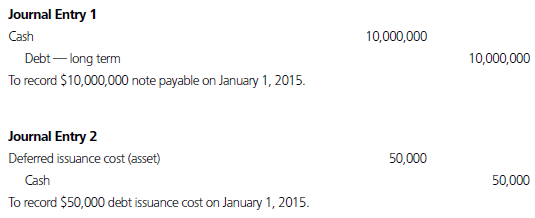Heads Up — Simplifying the presentation of debt issuance costs
by Mathew Lorie and Magnus Orrell, Deloitte & Touche LLP
Introduction
On October 14, 2014, the FASB issued a proposed ASU1 that would change the presentation of debt issuance costs in the financial statements. Under the proposal, an entity would present such costs in the balance sheet as a direct deduction from the debt liability in a manner consistent with its accounting treatment of debt discounts. Amortization of the issuance costs would be reported as interest expense. Comments on the proposal are due by December 15, 2014.
This Heads Up provides background on the proposed ASU and describes its key provisions.
Background
The FASB’s project on the presentation of debt issuance costs is part of the Board’s simplification initiative, which focuses on projects that are narrow in scope and involve limited changes to guidance that can be made quickly. Launched in June 2014, the simplification initiative is intended to reduce the cost and complexity of current U.S. GAAP while maintaining or enhancing the usefulness of the related financial statement information.
Currently, ASC 835-30-45-32 requires that an entity report debt issuance costs in the balance sheet as deferred charges (i.e., as an asset).
|
Editor’s Note: Presenting debt issuance costs as an asset is inconsistent with the presentation of debt discounts and premiums under U.S. GAAP and also conflicts with IFRSs, under which transaction costs that are directly attributable to the issuance of the liability are treated as an adjustment to the initial carrying amount of the financial liability. It is also contrary to the SEC staff’s views regarding the treatment of equity issuance costs as a reduction of the gross proceeds of an equity offering. Furthermore, the current treatment under U.S. GAAP of debt issuance costs is inconsistent with FASB Concepts Statement No. 6,3 which states, “Debt issue cost is not an asset for the same reason that debt discount is not — it provides no future economic benefit. Debt issue cost in effect reduces the proceeds of borrowing and increases the effective interest rate and thus may be accounted for the same as debt discount.” |
Key Provisions of the Proposed ASU
Under the proposal, the guidance on debt issuance costs in ASC 835-30 would be amended to read as follows:
- “[I]ssue costs shall be reported in the balance sheet as a direct deduction from the face amount of the note. The . . . issue costs shall not be classified as a deferred charge.”
- “[I]issue costs shall be reported as interest expense.”
The FASB has not yet deliberated the effective date of the proposed amendments and whether an entity would be permitted to early adopt them. An entity would apply the new guidance retrospectively to all prior periods.
According to the proposal, an entity would be required to “disclose in the first annual period after the entity’s adoption date, and in the interim periods within the first annual period, the following:
- The nature of and reason for the change in accounting principle
- The transition method
- A description of the prior-period information that has been retrospectively adjusted
- The effect of the change on the financial statement line item.”
The proposed amendments would not affect the recognition and measurement guidance on debt issuance costs. For example, the costs of issuing convertible debt would not affect the calculation of the intrinsic value of an embedded conversion option that represents a beneficial conversion feature in accordance with ASC 470-20-30-13. Thus, entities may still need to track debt issuance costs separately from debt discount.
The following example illustrates how an entity would record debt issuance costs before and after adopting the proposed ASU’s guidance:
| Example |
|---|
|
On January 1, 2015, an entity issues a debt security with a face amount of $10,000,000 to an investor. On the same date, the entity incurs and pays incremental and direct issuance costs of $50,000 to parties other than the investor. The debt security matures in five years (on December 31, 2020). Before adopting the guidance in the proposed ASU, the entity would record the $50,000 in debt issuance costs on January 1, 2015, as follows: After adopting the guidance in the proposed ASU, the entity would record the $50,000 in debt issuance costs on January 1, 2015, as follows: |
____________________
1 FASB Proposed Accounting Standards Update, Simplifying the Presentation of Debt Issuance Cost.
2 For titles of FASB Accounting Standards Codification (ASC) references, see Deloitte’s “Titles of Topics and Subtopics in the FASB Accounting Standards Codification.”
3 FASB Concepts Statement No. 6, Elements of Financial Statements.







